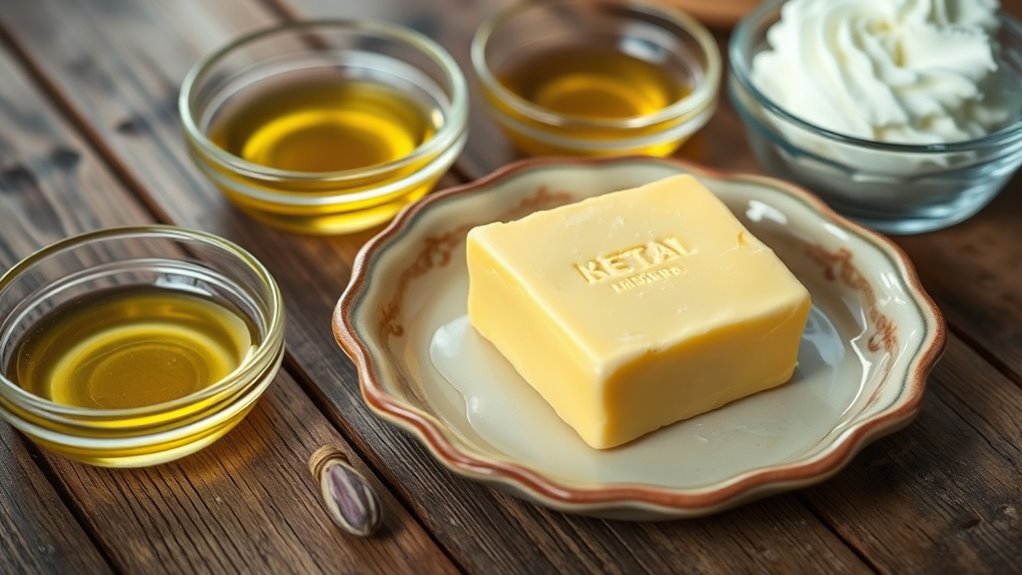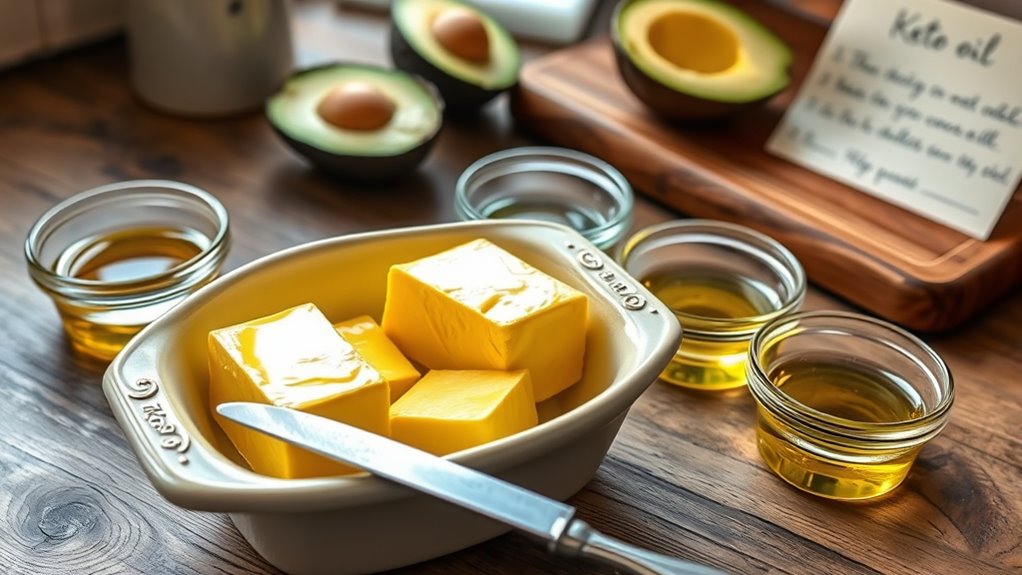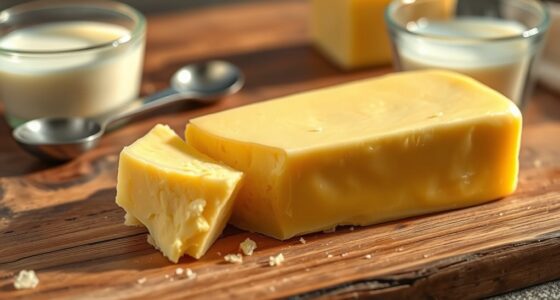For a keto diet, 1 to 4 tablespoons of butter daily usually works well, but moderation is key. Using too much can raise your LDL cholesterol, increase heart risks, and lead to nutrient imbalances. Pay attention to signs like digestive issues or skin reactions, and balance butter with other healthy fats like avocados or nuts. To keep your diet balanced and safe, consider small portions and alternative fats—that’s just the beginning of what you’ll discover.
Key Takeaways
- Aim for 1 to 3 tablespoons of butter daily to support keto goals without overconsumption.
- Monitor for signs of excess, such as digestive issues or fatigue, to prevent health risks.
- Use portion control methods like measuring servings to avoid overuse.
- Balance butter intake with other healthy fats like avocados, nuts, and fatty fish.
- Be mindful of butter’s flavor richness, which can lead to overapplication if not measured.
The Nutritional Profile of Butter and Its Role in Keto

Butter is a rich source of healthy fats, making it a popular choice for those following a ketogenic diet. Its flavor profiles range from creamy and mild to nutty and savory, adding depth to your meals. When considering butter’s role in keto, focus on its high fat content and minimal carbs, which support ketosis. Proper butter storage tips are essential to preserve freshness and prevent spoilage – keep it in an airtight container in the fridge, and avoid exposing it to light or heat. This ensures you maintain its quality and flavor. Incorporating butter into your keto plan not only enhances taste but also provides essential fats that fuel your body efficiently. Additionally, understanding its nutritional profile helps you optimize your diet while enjoying its rich, satisfying flavors.
Recommended Daily Butter Intake for Keto Enthusiasts

To stay in ketosis, you should keep your daily butter intake within recommended limits. Balancing your fat consumption with other nutrients is key to avoiding excess calories and maintaining overall health. Let’s explore how to determine the right amount and keep your diet properly balanced. Being mindful of your relationship patterns can also help you maintain a healthy mindset and prevent emotional eating habits.
Daily Butter Limits
Most keto enthusiasts find that consuming about 1 to 4 tablespoons of butter daily fits well within their dietary goals. Staying within this range helps maintain ketosis without overdoing fat intake. However, if you have butter allergies, you should limit or avoid butter altogether and explore alternatives. Proper butter storage is vital to prevent spoilage and ensure freshness, especially if you buy in bulk. Keep butter in a cool, dark place or in the refrigerator to extend its shelf life. Remember, moderation is key, so stick to your daily limits to avoid potential health issues or digestive discomfort. Monitoring your butter intake helps you enjoy its benefits while maintaining a balanced keto lifestyle. Additionally, understanding how to organize your space can help create a more calming environment that supports your health and wellness goals.
Fat Intake Recommendations
While individual needs vary, consuming about 1 to 4 tablespoons of butter daily generally supports a keto lifestyle. This range ensures you get enough saturated fat to maintain ketosis without overdoing it. If you prefer butter substitutes like ghee or coconut oil, they can also provide healthy fats, but be mindful of their fat profile. Keep in mind that excessive saturated fat intake from butter or substitutes might raise your cholesterol levels, so moderation is key. Your total fat intake should align with your personal calorie needs and goals. Tracking your daily fat consumption helps prevent overconsumption. Remember, balancing fats with other nutrients is essential, but sticking within this butter range keeps your fat intake consistent with keto recommendations. Additionally, understanding the horsepower of electric dirt bikes can help you appreciate how different fat sources support overall energy levels.
Balancing Nutrients Properly
Balancing nutrients properly on a keto diet requires paying attention to your butter intake to guarantee you get enough healthy fats without overdoing it. While butter is a popular source, you can also consider butter substitutes like ghee or coconut oil to diversify your fat sources. These alternatives can help prevent nutrient imbalances and support overall health. Proper nutrient timing is essential; spreading your fat intake throughout the day ensures consistent energy levels and aids digestion. Monitoring your butter consumption ensures you stay within recommended limits, typically around 1-3 tablespoons daily, depending on your needs. Incorporating a variety of Crochet Styles for Locs can also help you enjoy your diet plan with creative expression. Remember, balancing your fat sources and timing your intake helps optimize your keto experience without risking excess calories or nutrient deficiencies.
Recognizing Signs of Excessive Butter Consumption

Consuming too much butter can lead to noticeable health issues, signaling that your intake may be excessive. If you experience symptoms like skin rashes, swelling, or difficulty breathing, you might have a butter allergy, which indicates you should cut back. Additionally, if your flavor preferences are heavily skewed toward butter, you may be consuming more than your body needs, risking imbalance. Pay attention to digestive discomfort, such as bloating or diarrhea, which can also be signs of overdoing it. Persistent fatigue or feeling sluggish could point to excessive saturated fat intake. Recognizing these signs early helps you adjust your diet before more serious health consequences arise. Moderation is key to enjoying butter’s benefits without overstepping your body’s limits. Glycolic acid benefits can also serve as a reminder that moderation is essential when using potent ingredients or foods to maintain healthy skin and body functions.
Health Risks Associated With Overdoing It on Butter

Eating too much butter on a keto diet can pose serious health risks. If you have dairy allergies, excessive butter intake might trigger allergic reactions, leading to discomfort or more severe issues. Even if you’re not allergic, consuming large amounts of butter can raise your cholesterol concerns. Butter contains saturated fats, which may increase LDL (“bad”) cholesterol levels, potentially raising your risk of heart disease over time. Overdoing it can also contribute to inflammation and other metabolic problems. It’s important to balance butter consumption with other healthy fats and monitor your overall intake. Staying mindful of how much butter you add to your meals helps you avoid these health pitfalls while maintaining a balanced, effective keto diet. Additionally, being aware of the role of fat quality in your diet can help optimize your health outcomes.
Practical Tips for Moderating Your Butter Intake

To keep your butter intake in check, try using portion control strategies like measuring servings or spreading it sparingly. Incorporate healthy fats from sources such as avocados or nuts to diversify your diet. Remember to balance your butter consumption with other nutrient-rich foods to maintain overall health. Additionally, being mindful of best colognes can help you feel confident and well-groomed while sticking to your dietary goals.
Portion Control Strategies
Managing your butter intake on a keto diet doesn’t have to be challenging if you implement simple portion control strategies. Start by using small, designated utensils to measure your butter, which helps avoid accidental overuse and maintains the desired butter flavor without excess. Store your butter properly in airtight containers in the fridge or freezer to keep it fresh and ready for controlled portions. When cooking, consider pre-portioning butter into small containers or using a butter stick with marked measurements for quick, accurate serving sizes. Pay attention to serving sizes on labels and use visual cues, like tablespoons or teaspoons, to stay within your daily limits. Incorporating keto-friendly kitchen tools can further streamline your portion control habits. These habits make it easier to enjoy butter’s richness while keeping your intake in check.
Incorporate Healthy Fats
Incorporating healthy fats into your keto diet helps balance your intake and supports overall health, even when moderating butter consumption. Instead of relying solely on butter flavoring or butter packaging, diversify your sources by adding avocados, nuts, seeds, and fatty fish. These options provide essential nutrients and healthy fats that complement your diet. When using butter flavoring, opt for natural, minimally processed products to avoid excess additives. Be mindful of portion sizes and incorporate different fats throughout the day to prevent overconsumption of any one type. Additionally, understanding net worth growth hacks can inspire you to optimize your diet for better health and financial well-being. By expanding your fat sources, you maintain a flavorful, satisfying diet while reducing the risk of excess butter intake. This approach helps you enjoy the benefits of fats without overdoing it on butter.
Balance With Other Foods
Balancing your butter intake involves incorporating a variety of nutrient-dense foods into your meals to prevent overreliance on butter’s rich flavor. Use different cooking techniques, like roasting, steaming, or grilling, to add variety and naturally enhance flavors without extra butter. Incorporate herbs, spices, and acidic ingredients such as lemon juice or vinegar to boost flavor enhancement without increasing fat content. Pair butter with vegetables, lean proteins, and healthy fats from nuts and seeds to create balanced meals. This approach helps you enjoy butter without overdoing it, supporting your keto goals. By diversifying your foods and cooking methods, you’ll maintain a flavorful, satisfying diet while keeping butter consumption in check.
Alternatives to Butter for a Balanced Keto Diet

Are there tasty and nutritious alternatives to butter that fit into a balanced keto diet? Absolutely. You can explore various butter substitutes and dairy alternatives that provide healthy fats without sacrificing flavor. Coconut oil is a popular choice, offering a rich texture and beneficial medium-chain triglycerides. Avocado oil is another excellent option, packed with monounsaturated fats and neutral taste. For dairy-free options, consider plant-based spreads made from nuts or seeds, such as almond or sunflower seed butter. These alternatives help you maintain the high-fat, low-carb ratio essential for keto. By incorporating these options, you diversify your fat sources and enjoy different flavors and textures, making your keto journey more enjoyable and sustainable.
Frequently Asked Questions
Can Butter Consumption Affect Ketosis Levels?
You might wonder if butter consumption affects ketosis levels. It can, especially if you eat large amounts that push your daily carb limit. Using butter for flavor adds healthy fats, but be mindful of butter storage to prevent spoilage. Moderation is key—stick to your keto macros, and enjoy butter in small amounts without risking ketosis. Proper storage guarantees freshness, helping you maintain your diet effectively.
Are There Specific Butter Types Better for Keto?
Ever wondered if some butters are better for your keto journey? When choosing butter, opt for grass-fed options—they often have richer flavorings and healthier fats. Check the butter shelf life to guarantee freshness, as fresher butter maintains its quality. While all butter can fit into keto, those with minimal additives and natural flavorings support your goals. Would you prefer a creamy, pure butter or one with added flavorings?
How Does Butter Impact Cholesterol on Keto?
You might wonder how butter impacts cholesterol on keto. While butter can raise LDL cholesterol in some people, it also can improve blood sugar control and support weight loss when eaten in moderation. Watch out for butter and blood sugar spikes, especially if you’re sensitive. Too much butter can lead to weight gain, so balance your intake. Focus on quality and enjoy it as part of a balanced keto plan.
Is Grass-Fed Butter Healthier Than Regular Butter?
You might wonder if grass-fed butter is healthier than regular butter. Grass-fed options typically contain more omega-3s and antioxidants due to different dairy alternatives and less processed butter processing. While grass-fed butter offers some nutritional benefits, both types are still high in saturated fats. Ultimately, moderation matters, and choosing high-quality, minimally processed butter aligns better with your health goals on a keto diet.
Can Butter Cause Digestive Issues in Keto Diets?
While butter can be a tasty addition to your keto journey, it might sometimes cause gentle tummy whispers, especially if you have dairy sensitivities. These sensitivities can affect fat digestion, leading to discomfort or bloating. If your body’s signals suggest trouble, consider moderating your butter intake or exploring alternatives. Listening to your body’s cues helps ensure your keto experience stays smooth and enjoyable without unnecessary digestive hiccups.
Conclusion
Ultimately, mastering moderation makes your keto journey joyful. By balancing butter’s benefits with its potential pitfalls, you prevent problems and promote progress. Keep your consumption controlled, cravings conquered, and choices chiseled carefully. Remember, mindful moderation maximizes benefits and minimizes mishaps. So, savor your snacks, stay savvy, and steer clear of overdoing it. Your keto adventure becomes easier, enjoyable, and oh-so-effective when you practice prudent portions and prioritize progress over perfection.










